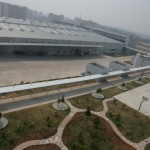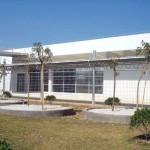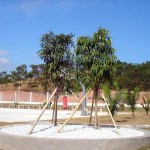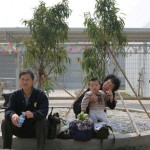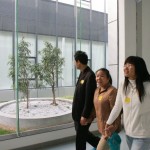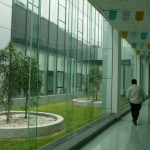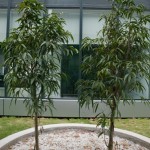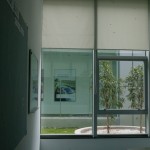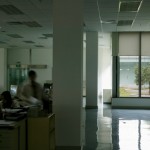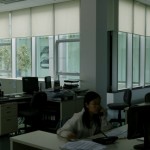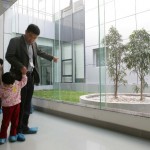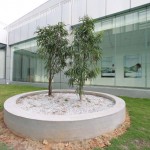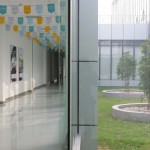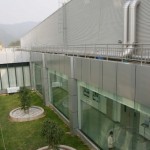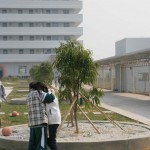The series of “What are they doing here?” Projects attempt to foster lively communication between Chinese artists and employees of Siemens subsidiaries. In these Projects, employees are invited not only to perceive their work environment in terms of business, but also to experience the emotional, social and creative dimension of it. This process-oriented approach aims to get everybody actively involved.
The artist Chu Yun was asked by Siemens VDO and Siemens Arts Program to create an independent artwork for the new site in Huizhou. He planted trees in pairs alongside the new Siemens VDO site, and with that liked the factory with the residential area.
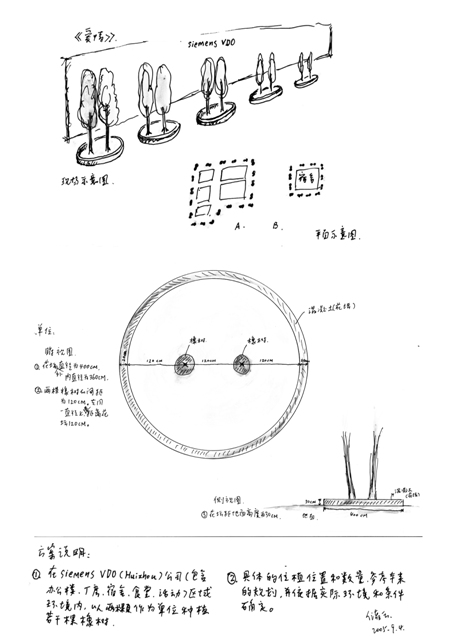
They Are Growing, Entering into People’s Lives
Hu Fang
Allow artworks to penetrate this sort of space without fanfare, gradually discovering their own influence. People are hardly aware of how the works operate, but at select moments when they encounter them, they view not merely with an eye to easy belief or doubt.*
Pairs of trees, planted 1.2 meters apart from each other, distributed among the office area, living area, and production area of the Siemens VDO (Huizhou) Company’s new factory complex.
Perhaps my description of this work can only go this far.
They are distributed around the periphery of the factory complex, looking at first glance as if they are just slightly different from ordinary landscaped belts in factories throughout the Pearl River Delta. The difference is not huge, regardless of whether you assume an attitude of “easy belief” or “easy doubt,” they all survive in the same way.
Chu Yun’s works always end up in a state of ineffability, just as the young Wittgenstein wrote in his Philosophical Investigations: “All that which can be said can be said clearly, but all that which cannot be said should be held in silence.” Chu Yun’s works likewise draw a boundary between visual and intellectual expression.
In a moment of seemingly unlimited possibility for art, Chu Yun’s works seem to have returned to a basic question: the boundaries of personal life and the boundaries of art.
In fact, that which changes us is not necessarily those things of which we have explicit consciousness, or even the things that we able to remember. I think we are more easily disposed to being unconsciously changed by things we cannot easily observe, and that these things change us even more quickly and drastically.
Exploration of boundaries must be undertaken quietly and subtly. In Chu Yun’s early works, his explorations always unfold around the materials of personal, everyday life. In “The Light of Rented Rooms,” he used colored paper to bring some life to dark rented rooms belonging to poor young migrant workers. In “1607″ he shot nearly 6000 photos in his own apartment of less than twenty square meters and then stacked them together, creating a “brick-like” photographic installation; people knew that behind the first photograph there were many more that could not be seen. In “Who Stole Our Bodies?” he assembled pieces of soap collected from his friends as a way of symbolizing both material disappearance and individual fate.
As far as Chu Yun is concerned, the meaning of artistic creation lies perhaps precisely in the gaps between the stacked photographs, or in the differences among each individual piece of soap. The artist is he who brings microscopic changes into life, and in doing so, microscopically influences the traces left by life.
Chu Yun has remained in continual pursuit of things that mask pain and happiness, skeptical of dispositions that can be clearly defined, brought on by explicit suffering, joy, tragedy, or anger. Chu Yun’s pursuit of the “hidden” derives from his recognition of the real. This has, in turn, made him more and more willing to abandon the use of strong visual images to attract people, and left him to ponder the question of how an artist can become a medium for transcending the visible stuff of everyday life.
I always hoped to do a work about friendship. How does enthusiasm arise out of mutual understanding? Perhaps I am we, and we are just a strange illusion. The work “Love” is about “two” and “one,” about “units,” about “me” and “you,” and about the “one” that we can create using objects and their position in reality.
Chu Yun’s encounter with Siemens VDO (Huizhou) Corporation happened exactly as the company was moving from old to new facilities. In this process, it is possible to see how enterprise, as an organic entity, is able to break through contradictions, how it renews and develops itself. It is possible to sense the position and disposition of the individual in this massive machine. In fact, everyone has had the experience of living inside a massive system, and this machine-like system takes efficiency and market-value as its final mandates. The individual is thus, driven by the necessities of survival, divided into two.
So what can art bring? How can art speak to the people here?
I never intentionally create any obstacles to understanding, it’s just that from the beginning I have tried hard to avoid some things that others believe to be extremely important. At the same time, some viewers (including some viewers who do not quite understand contemporary art) are very quickly able to understand what I am doing, to the point where no one has to explain anything.
Chu Yun sees “love” as another source, opposed to the machine-system. He sees it as a medium for re-integrating broken entities, for turning two into one. He chose trees, at once a basic component of daily life and a symbol of nature. He does not emphasize the symbolism of the tree, but merely recognizes it. He worked with the landscape architects of the new factory complex to place his works into the plan they were creating for real life. For this reason, the realization of the works as well as their final visual form all take on the appearance of everyday materials. The works’ artificiality and position in real life force people to view them using the insight they would apply to things in real life: this is the “encounter” that Chu Yun seeks to create between his viewers and his works.
Seen from the surface, in this work “Love,” the artist has only slightly changed the method of planting trees: he takes the trees used for urban “greenification” programs and plants them as couples, distributed around the periphery of the factory complex. But this subtle manipulation frames the artist’s consciousness of art and place, and of the relations among people, making him able to connect to his own daily life “without difficulty.”
At the opening of the art program “What Are They Doing Here?” on Valentine’s Day, February 14, a day which also the 20th anniversary of the Siemens VDO (Huizhou) Corporation as well as the opening of the new factory, general manager Tan said: “an enterprise must have love, and once it has love it has everything.” The day before, family visitation day, Chu Yun opened a studio, and a number of workers came to debate with him. A single work can have many different interpretations, and people can choose the one that suits them. But for Chu Yun, “Love” is a metaphor, referring to an unnamable energy.
Perhaps after a year or several, people will no longer take these trees as works of art (perhaps the current crop of workers will all be gone, and the newcomers will be unclear as to what the trees mean. Perhaps they will not be interested.) Everyone will have come to accept the “pairs of trees planted together” as natural; the curiosity will be gone. At that time, this work will become a part of reality, and a part of people’s daily lives. This process is the antithesis of creation as one-time event. Perhaps it is a failed movement, but it is nonetheless an affirmation of the ideals in these works.
The trees are growing, entering into people’s lives. Even as Chu Yun casts doubt on art and the boundaries of the everyday world, he is also structuring the relationship between art and each of our daily lives.
Note: All of the bolded text in this article comes from Chu Yun’s conversations and e-mail debates with the author.
